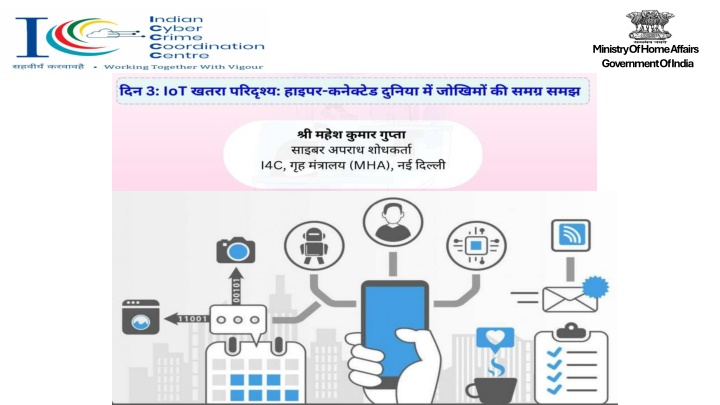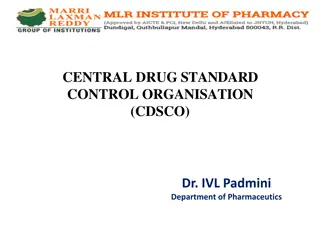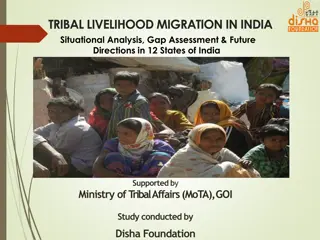
Ministry Of Home Affairs Government Of India
The Ministry of Home Affairs is a key government department in India responsible for internal security, border management, and overall homeland security. It plays a crucial role in maintaining law and order, safeguarding the country's sovereignty, and coordinating responses to emergencies and natural disasters. The ministry's functions include overseeing police forces, managing intelligence agencies, and handling issues related to citizenship and immigration. As an essential pillar of the Indian government, the Ministry of Home Affairs works tirelessly to ensure the safety and well-being of the nation's citizens.
Download Presentation

Please find below an Image/Link to download the presentation.
The content on the website is provided AS IS for your information and personal use only. It may not be sold, licensed, or shared on other websites without obtaining consent from the author. If you encounter any issues during the download, it is possible that the publisher has removed the file from their server.
You are allowed to download the files provided on this website for personal or commercial use, subject to the condition that they are used lawfully. All files are the property of their respective owners.
The content on the website is provided AS IS for your information and personal use only. It may not be sold, licensed, or shared on other websites without obtaining consent from the author.
E N D
Presentation Transcript
Ministry Of Home Affairs Government Of India
Agenda What is IoT ? Why do we need IoT ? What is IoT Security ? Common Threat to IoT IoT Real Time Applications Role of IoT in a hyper-connected world Challenges in IoT Security ? Best Practices for Securing IoT Top 10 IoT Careers to Explore in 2024
A network of interconnected devices that communicate and share data to perform tasks. By 2025, there will be 75 billion IoT devices globally (Statista, 2024). The global IoT market is expected to reach $1.6 trillion by 2030 (Fortune Business Insights). 90% of IoT devices collect personal data, from location to health metrics (IDC, 2023).
What is IoT ? The Internet of Things (IoT) refers to a network of interconnected devices that communicate and exchange data with each other over the internet. The Internet of Things integrates everyday things with the internet.
Why do we need IoT? 1. Enhanced Efficiency: IoT automates processes and optimizes resource usage, reducing operational costs and saving time. 2. Real-time Monitoring: Provides real-time data on systems and environments, enabling proactive maintenance and quicker response to issues. 3. Improved Decision Making: Analyzes vast amounts of data to provide actionable insights, leading to better, data-driven decisions.
Why do we need IoT? 4. Increased Connectivity: Connects devices and systems for seamless communication and coordination, improving overall functionality. 5. Innovative Solutions: Drives innovation by enabling new applications and services across various industries, from smart cities to healthcare.
What is Threat in IoT ? 1. An IoT attack is a malicious attempt to exploit vulnerabilities in internet-connected devices, such as smart home devices, industrial control systems, and medical devices. 2. Attackers may gain control of the device, steal sensitive data, or use the device as a part of a botnet for other malicious purposes.
What is IoT Security ? 1. Anything connected to the Internet is likely to face attack at some point. 2. IoTdevices are computerized Internet-connected objects, such as networked security cameras, smart refrigerators, and WiFi-capable automobiles. IoT security is the process of securing these devices and ensuring they do not introduce threats into a network. 3. They can utilize an IoT device to steal data, launch distributed denial-of-service (DDoS) attacks, or try to compromise the rest of the linked network once they have control of it.
Risks of IoT Devices: What are IoT Devices? Devices like smart home gadgets (thermostats, cameras, lights, etc.), wearable devices, smart appliances, and connected vehicles. Vulnerabilities: IoT devices often have weak security, can be hacked, and may provide attackers with entry points into home or business networks.
Common Threat to IoT Threat Device Hijacking Description Hackers gain unauthorized control over IoT devices, often purposes. Sensitive data is intercepted while being transmitted between networks. Attackers have the ability to read and change communications between IoT devices and servers. Malicious software is installed on IoT devices to disrupt functionality or demand ransom. for malicious Data Interception devices and Man-in-the- Middle Attacks Malware Ransomware &
Common Threat to IoT Threat Denial-of- Service (DoS) Description Attackers overload devices or networks, making them unavailable to users. Hackers can gain access to IoT systems or data by exploiting poorly secured APIs. Passwords of IoT devices are easy to guess. IoT devices that are not updated are open to hacking attacks. Attackers manipulate physical devices to gain access to sensitive data or systems. Insecure APIs Weak Passwords Lack of Updates Physical Tampering
Best Practices for IoT Device Security: 1.Change Default Passwords: 1. Always change the default password to a strong, unique one. 2.Regular Firmware Updates: 1. Ensure IoT devices are regularly updated to fix security vulnerabilities. 3.Network Segmentation: 1. Isolate IoT devices on a separate network to limit potential breaches. 4.Use Secure Communication Protocols: 1. Opt for devices that use encryption and secure protocols (like HTTPS, WPA3). 5.Disable Unused Features: 1. Turn off features like voice recognition or cameras when not in use. 6.Monitor and Audit Devices: 1. Regularly check for unusual activity or signs of intrusion.
How do identify Fake Apps? Check the reviews Look for grammar mistakes Check the number of downloads Research the developers Be cautious about images and screenshots Review permissions 1. 2. 3. 4. 5. 6.
IoT Real Time Applications Smart Homes: IoT enables automation of lighting, heating, security systems, and appliances, creating energy-efficient and convenient living environments. Home
IoT Real Time Applications Smart Cities: IoT solutions manage traffic, monitor air quality, and enhance public safety through connected infrastructure.
IoT Real Time Applications Healthcare: Wearable devices and remote monitoring systems track patient vitals, ensuring timely interventions and personalized care. Agriculture: IoT-powered sensors monitor soil moisture, weather conditions, and crop health, optimizing irrigation and boosting yield. Industrial IoT (IIoT): Sensors and smart devices monitor equipment health, optimize production, manufacturing processes. and reduce downtime in
What all can be reported URL WHATSAPP NUMBER TELEGRAM HANDLE PHONE NUMBER EMAIL ID SMS HEADER SOCIAL MEDIA URL DEEPFAKE VIDEOS https://cybercrime.gov.in/
Role of IoT in a Hyper-connected world 1. The role of IoT in a Hyper-connected world helps in connecting a whole ecosystem to the internet. 2. This ecosystem may be comprised of people, processes, devices, and data, and is geared to offer superior user experiences. 3. IoT is aiming at exploring new opportunities, providing richer experiences, creating new capabilities. 4. IoT is about the sharing of information in real-time, any performance- related issue in one part of the ecosystem can unfavorably impact the other as well.
Best Mobile Practices : 1.Use Strong Passwords/Authentication: 1. Enable biometric authentication (fingerprint, facial recognition). 2. Use strong, unique passwords and PINs. 2.Enable Device Encryption: 1. Protect stored data by encrypting the device. 3.Keep Software Up to Date: 1. Regularly update operating systems and apps to patch vulnerabilities. 4.Install Trusted Security Apps: 1. Use reputable antivirus and anti-malware apps. 5.Avoid Public Wi-Fi for Sensitive Transactions: 1. Use a Virtual Private Network (VPN) when connecting to public Wi-Fi. 6.Backup Your Data: 1. Regularly back up your device data to cloud storage or an external device.
Role of IoT in a Hyper-Connected world 1. The role of IoT in a hyper-connected world helps in connecting a whole ecosystem to the internet. 2. This ecosystem may be comprised of people, processes, devices, and data, and is geared to offer superior user experiences. 3. IoT is aiming at exploring new opportunities, providing richer experiences, creating new capabilities. 4. IoT is about the sharing of information in real-time, any performance-related issue in one part of the ecosystem can unfavorably impact the other as well.
Best Practices for Securing IoT Consumer IoT Security Best Practices- i. Ensure Unique Credentials ii. Store credentials and security-sensitive data securely iii. Validation is required for data input via user interfaces and data transmission via APIs or between networks in devices and services. iv. Implement a vulnerability disclosure policy. v. Keep Software Up to Date. vi. Ensure the protection of personal data.
Best Practices for Securing IoT Industrial IoT Security Best Practices i. Network Segmentation- To access a network shared by office PCs and IIoT equipment, the attacker can use phishing emails or malware to deceive employees. ii. Have an emergency response team in place. iii. Secure and Preventive Maintenance Procedures Preparation.
Best Practices for Securing IoT Cloud IoT Best Practices- i. Introducing planned defensive measure methodology. ii. Updating passwords on Cloud-based devices at regular intervals . iii. Keep Authentication Keys Safe. iv. Securing all the layers.
Top 10 IoT Careers to Explore in 2024 1. IoT Architect- it is one of the most demanding careers in IoT fields 2. Embedded System Designer- The main responsibility of an IoT system designer is to develop device-specific firmware by using multiple programming languages such as C++, Python, and so on. 3. IoT Network engineers - To maintain the IT infrastructure to ensure the proper functionalities of all the connections in the IoT networks. 4. IoT Systems Administrator- The main responsibility is to ensure that ever peripheral is working fine fine within the organization and also to keep check on their perfomance.
Top 10 IoT Careers to Explore in 2024 1. Test Engineer - To define and evaluate innovative smart products that go beyond customer expectations. 2. Sensor and Actuator Professional - To keep track of the industry and perform research on multiple new technologies that are available in the market. 3. IoT Solution Engineer - Responsible for working closely with the customers and designing a needed solution.
Top 10 IoT Careers to Explore in 2024 8. Safety Engineer - Make sure that the IoT technologies being developed are safe from hackers. 9. IoT Developer - IoT developers are to support the IoT applications by reducing the manufacturing cycle time, quality of the production adn raising the viability of the supply chain. 10. Embedded Program Engineer To reliable code that communicates with their third party through a variety of protocols and APIs. Courses in IoT i. Certification courses from IITs. ii. B. Tech in AI, IoT specialization etc..






















